Unit 7
1/146
There's no tags or description
Looks like no tags are added yet.
Name | Mastery | Learn | Test | Matching | Spaced |
|---|
No study sessions yet.
147 Terms
species
A group of organisms that can interbreed and produce fertile offspring.
fertile offspring
capable of producing viable offspring
reproductively isolated
when a group of organisms is prevented from interbreeding with other groups
Pre-zygote barriers
mechanisms that prevent mating or fertilization between species
post-zygote barriers
mechanisms that occur after fertilization, preventing the development of viable or fertile offspring.
Habitat isolation
Two species might prefer different habitats and thus be unlikely to encounter one another
temporal isolation
Two species might reproduce at different times of the day or year and thus be unlikely to meet up when seeking mates
Two species might have different courtship behaviors or mate preferences and thus find each other "unattractive"
Behavior isolation
Two species might produce egg and sperm cells that can't combine in fertilization, even if they meet up through mating.
Gametic isolation
Two species might have bodies or reproductive structures that simply don't fit together.
Mechanical isolation
Reduced hybrid fertility
The condition where hybrid offspring are sterile and cannot reproduce, preventing gene flow between the parent species.
Reduced Hybrid Viability
(survivability) Parents have incompatible genetics and the hybrid offspring fails to develop
speciation
The evolutionary process by which populations evolve to become distinct species, often due to reproductive isolation.
sexual selection
The process by which certain traits increase an individual's chances of reproducing based on preference by one sex for certain characteristics in individuals of the other sex.
Allopatric speciation
when two different populations are living in different geopgraphic regions, which prevent sgene flow and thus speciation occurs when they are geographically isolated.
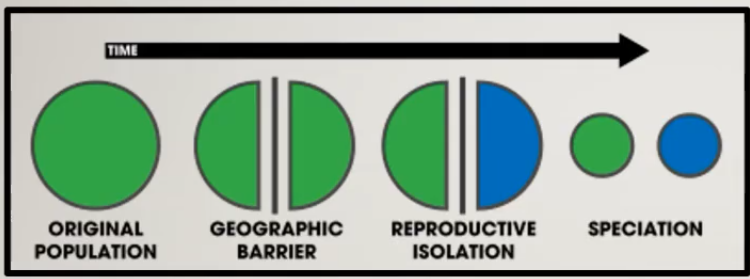
Sympatric speciation
Occurs when two different populations living in the same environment and different isolation mechanisms prevent gene flow
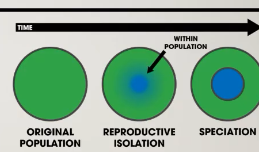
Punctuated equilibrium
Evolution occurs after a long period of stasis (a period of little to no change) and followed by a rapid bursts of speciation
Gradualism
The theory that evolution occurs slowly and steadily over time, with gradual changes leading to speciation.
divergent evolution
populations become seperated by geographic barriers and evolve indepedntly into their own species. Different habitats and become more different over time. Same common ancestor
convergent evolution
the process by which unrelated species evolve similar traits or adaptations due to similar environmental pressures, despite having different ancestors.
adaptive radiation
A type of divergent evolution where a group of organisms quickly diverge into new species. Different niches are occupied, leading to a rapid evolution of diversity.
It is possible for complex molcules to be built from inorganic molecules
origins of life
Extinction
can be caused by catastrophic changes to an ecosystem such as solar flares, rising seal levels, volcanic eruptions, or asteroid impacts
Human activity that can increase extinction
Habitat loss, climate change, habitat degradation, pollution, and poaching
High biodiversity
high levels of speciation and low extinction
Low biodiversity
low levels of specification and high extinction
Niche
describes a role of an organism in an evironment; producer, decomposer, scavenger, consumer
Evidence for common ancestry in Eukaryotic
linear chromosomes, membrane bound organelles, and Genes that contain introns
Membrane bound organelles
Shown in Mitochondria and chloroplasts; have double membrane, endosymbiotic theory, and have ribosomes.
endosymbiotic theory
the hypothesis that eukaryotic cells evolved through a symbiotic relationship between different species of prokaryotes, leading to the formation of organelles like mitochondria and chloroplasts.
Linear Chromosomes
Found in all Eukaryotes. It differs from prokaryotic genomes (circular chromosomes ).
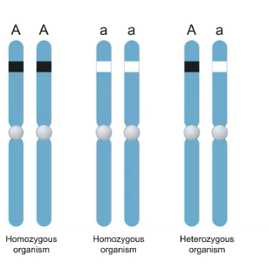
What is an Introns
non-coding sequences of DNA within a gene that are removed during RNA splicing.
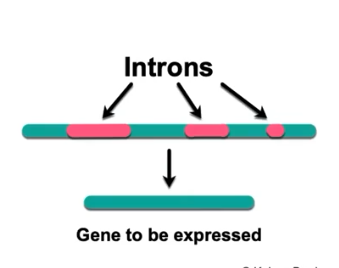
Intron for common ancestry
Found in all eukaryotes.
Genomic changes
Changes in DNA and Cell divison and environmental disruptions
Continous change in fossil records
Transition fossils can show the evolutionary changes as one groups evolve into another
Resistance to various chemicals
Resistance can show evolutionary changes in terms of new mutations
Fitness
The ability of an organism to reproduce
Pathogens
infectious agent that produce dieases, evolves, can become chemically compatible with its host, and can change phenotypes.
Viruses
They evolve rapidly
Virus Recombination
two different viruses swap genetic material (DNA or RNA) when they have hosted the same cell to create a new viral strain, potentially leading to new characteristics or abilities.
Random mutation
A change in DNA sequence
Macroevolution
large scale evidence for evolution: anatomy, embryology, molecular biology, biogeography, and fossils.
homologous
variation in a structure that was present in a common ancestor

analogous
structures that evolved independently in different species due to similar environmental conditions/selective pressures
evidence 1- molecular biology
DNA sequence comparisons can show how different species are related.
evidence 2- biogeography
These patterns provide clues about how species, both alive and extinct, are related to each other
evidence 3- fossils
are preserved remains, impression, or trace of once living organisms from the past, it tells us age/geographical data
evidence 4 - anatomy/embryology
Anatomical features shared between organisms (including ones that are visible only during embryonic development) can indicate a shared evolutionary ancestry
vestigial structure
A reduced feature that serves little to no purpose for the organism; for example; the human tailbone
Biochemical evidence
A comparison of DNA nucleotide sequences and/or protein amino acid sequences provides evidence for evolution and common ancestry
True or False: Analogous features is convergent evolution
True
reduction of isotope - like carbon 14
is a method used in radiometric dating to determine the age of organic materials by measuring the decay of carbon-14 isotopes.
Phylogeny
the evolutionary history and relationships among species or groups of organisms.
cladogram
a diagram based on shared characteristics.
monophyletic
describing a group of organisms that includes an ancestor and all its descendants, forming a clade.
Paraphyletic
describing a group of organisms that includes an ancestor but not all of its descendants, resulting in an incomplete clade.
polyphyletic
diagram that represents evolutionary relationships among organisms. Phylogenetic trees are hypotheses, not definitive facts. A group of organisms that does not include the most recent common ancestor of the members, typically formed from multiple clades.
nodes on a phylogenetic tree
They tell use the age of the most recent or less recent common ancestor.
branch on a phylogenetic tree
refers to the line representing the evolutionary pathway between two nodes, showing the relationship between different lineages.
root on a phylogenetic tree
the common ancestor of all organisms in the tree, serving as the starting point for the evolutionary relationships depicted.
Taxonomy
the science of classifying organisms into groups based on their evolutionary relationships and characteristics.
What tells you how closely related two species are
two species are more related if they have a more recent common ancestor and less related if they have a less recent common ancestor.

polytomy
a branch point in a phylogenetic tree where three or more descendant groups emerge, indicating uncertain relationships.
what can phylogenetic trees not tell us
we organize species into nested groups based on shared derived traits (traits different from those of the group's ancestor).it does not tell us the exact timing of evolutionary events or speciation.
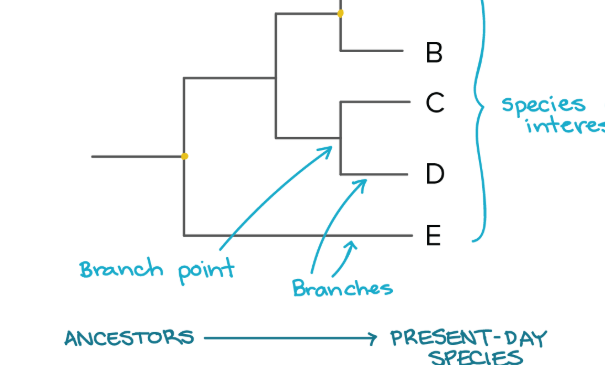
derived traits
traits that evolved within a group and differ from the ancestral trait.
In terms of DNA of relatedness
A larger number of differences corresponds to less related species
A smaller number of differences corresponds to more related species
Genomic changes
Changes in DNA and Cell divison and environmental disruptions
Continous change in fossil records
Transition fossils can show the evolutionary changes as one groups evolve into another
Resistance to various chemicals
Resistance can show evolutionary changes in terms of new mutations
Fitness
The ability of an organism to reproduce
Pathogens
infectious agent that produce dieases, evolves, can become chemically compatible with its host, and can change phenotypes.
Viruses
They evolve rapidly
Virus Recombination
two different viruses swap genetic material (DNA or RNA) when they have hosted the same cell to create a new viral strain, potentially leading to new characteristics or abilities.
Random mutation
A change in DNA sequence
Evidence for common ancestry in Eukaryotic
linear chromosomes, membrane bound organelles, and Genes that contain introns
Membrane bound organelles
Shown in Mitochondria and chloroplasts; have double membrane, endosymbiotic theory, and have ribosomes.
endosymbiotic theory
the hypothesis that eukaryotic cells evolved through a symbiotic relationship between different species of prokaryotes, leading to the formation of organelles like mitochondria and chloroplasts.
Linear Chromosomes
Found in all Eukaryotes. It differs from prokaryotic genomes (circular chromosomes ).

What is an Introns
non-coding sequences of DNA within a gene that are removed during RNA splicing.

Intron for common ancestry
Found in all eukaryotes.
Macroevolution
large scale evidence for evolution: anatomy, embryology, molecular biology, biogeography, and fossils.
homologous
variation in a structure that was present in a common ancestor

analogous
structures that evolved independently in different species due to similar environmental conditions/selective pressures
evidence 1- molecular biology
DNA sequence comparisons can show how different species are related.
evidence 2- biogeography
These patterns provide clues about how species, both alive and extinct, are related to each other
evidence 3- fossils
are preserved remains, impression, or trace of once living organisms from the past, it tells us age/geographical data
evidence 4 - anatomy/embryology
Anatomical features shared between organisms (including ones that are visible only during embryonic development) can indicate a shared evolutionary ancestry
vestigial structure
A reduced feature that serves little to no purpose for the organism; for example; the human tailbone
Biochemical evidence
A comparison of DNA nucleotide sequences and/or protein amino acid sequences provides evidence for evolution and common ancestry
True or False: Analogous features is convergent evolution
True
reduction of isotope - like carbon 14
is a method used in radiometric dating to determine the age of organic materials by measuring the decay of carbon-14 isotopes.
Evolution
"descent with modification," a process in which species change and give rise to new species over many generations.
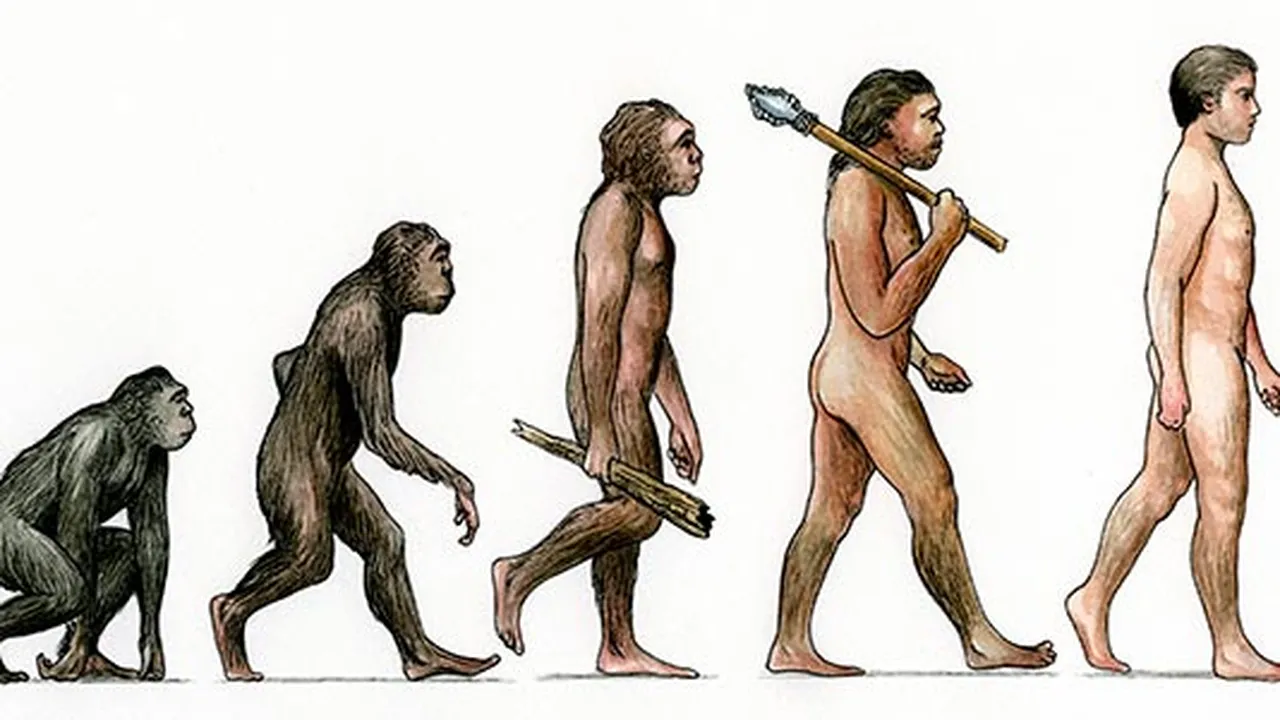
Adaptation
The process of changing to better fit an environment.
Natural selection
Nature’s way of selecting an organism because their trait favors the environment and they tend to survive and reproduce.
Variation
The differences between individuals within a population, which can lead to evolution through natural selection.
biodiversity
the variety of life in the world or in a particular habitat or ecosystem.
Evolution
"descent with modification," a process in which species change and give rise to new species over many generations.

Adaptation
The process of changing to better fit an environment.